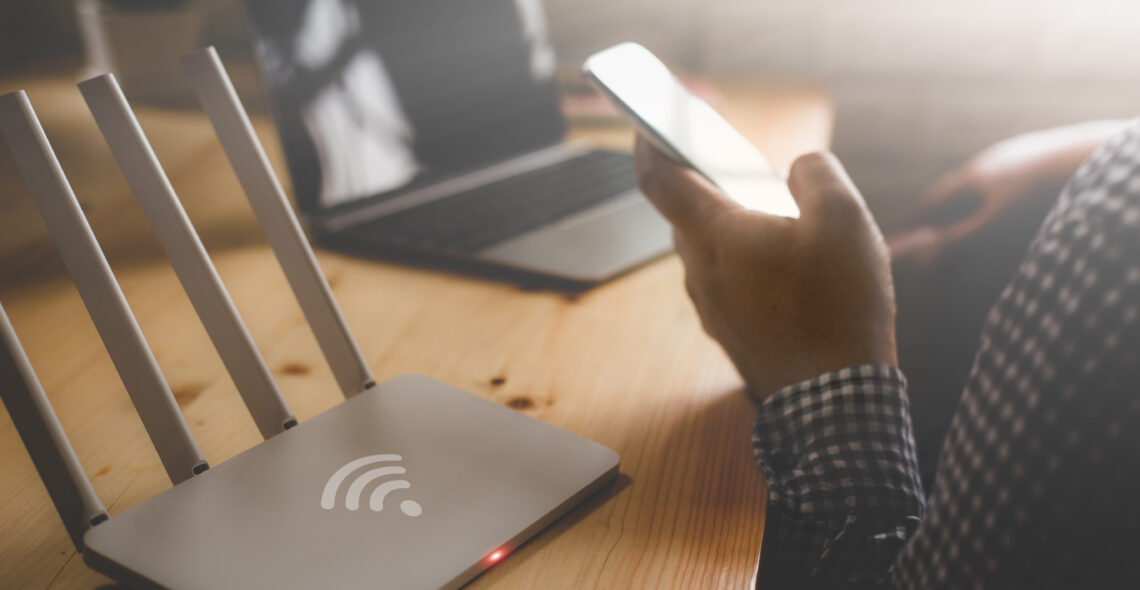Let’s start with the basics. Internet access allows organisations and individuals to connect to the internet using computers, smartphones, tablets and other compatible devices. It provides you with a connection to the World Wide Web, email and many other online services.
In this article we’ll answer the question ‘what is internet connectivity?’, explaining some of the terminology and the internet access methods and exploring your options for broadband services.
How do I access the internet?
Internet access is typically provided by internet service providers (ISPs). These companies sell their services to both businesses and consumers, allowing people to connect their devices to the internet.
As well as an ISP and a device, you’ll also need a wireless router. This is a piece of hardware supplied by the ISP, allowing you to connect more than one device at a time.
What is broadband?
Broadband is an umbrella term for a range of high-speed data transmission technologies employed to achieved an internet connection. Communications are enabled through a combination of copper cable, fibre optic cable and radio waves, and unlike narrowband internet, or dial-up, broadband is always connected.
Are broadband and Wi-Fi the same thing?
While the two are related, they achieve different things. Broadband is the connection that connects you to the internet, whereas Wi-Fi is the technology that allows your devices to interact with your connection.
Wi-Fi works by making use of radio frequencies to receive and send information wirelessly. When using Wi-Fi to access the internet, there is no need to physically plug your device into an Ethernet (hard wired) cable.
By comparison, your broadband connection is physically plugged into the router, which then uses Wi-Fi to distribute the signal virtually to devices in the immediate areas so that they can access the internet.
What are the advantages and disadvantages of Wi-Fi?
The main advantage of using Wi-Fi is that you’re relatively mobile, because your devices aren’t physically hard wired into the internet. It’s also convenient. The router is fairly cheap when you compare it to the purchase and labour costs of running additional cabling throughout a building.
Wi-Fi is also expandable. This means that you can connect multiple devices to your network at any one time, for example a whole family or team can enjoy a wireless connection to the internet.
That being said, there are limitations to Wi-Fi. The typical range of a Wi-Fi network is ten metres. To increase this range, users will need to invest in repeaters or signal boosters – these simply help to boost the Wi-Fi signal in the area, extending its reach. Alternatively, additional access points can be added.
Because Wi-Fi uses radio frequencies, it can also pick up interference, which may affect performance. And what you make up for in convenience, you may lose in speed. Wi-Fi can’t achieve anywhere near the speeds of a physical Ethernet cable network, so although Wi-Fi may be adequate for most people’s homes, it’s unlikely to provide enough coverage or capacity to support business usage.
What are my internet access options?
There are various types of connectivity services that can be used to access the internet. The most common are:
• Digital Subscriber Line (DSL)
• Fibre
• Mobile
• Satellite
• Hotspot
DSL is a form of broadband delivered over traditional copper telephone wires, which slows down the data the further it has to travel. For those selecting DSL, the speed of your connection is dependent on how close you are to the nearest telephone exchange.
Fibre broadband sends and receives data in a different way, as beams of light down fibre optic cables. This method is much faster than DSL, as fibre cables can handle far larger amounts of data, and speed isn’t affected by the distance travelled.
Mobile broadband is wireless internet access delivered over a 3G, 4G or 5G network supplied by a mobile phone service provider. As well as allowing you to access the internet on your smartphone, mobile broadband can be used to connect other devices to the internet by tethering them to your phone signal. This is known as mobile hot spotting.
As well as mobile hot spotting, hotspots are also physical locations where people can access the internet through a Wi-Fi connection when away from their usual router, such as at the home or office. Many cities and businesses now offer Wi-Fi hotspots for public use, helping people access a faster internet connection than what is often available through mobile networks.
Satellite broadband uses a satellite connection to bounce data to and from your premises. As it’s delivered by geostationary satellites, it’s available anywhere on the planet, and tends to be used in areas that don’t have access to a fixed broadband infrastructure.
Dedicated Internet Access from Neos Networks
At Neos Networks we offer a wide range of connectivity options for businesses across the UK, including:
• Dedicated Internet Access (DIA), delivers ultrafast and flexible internet access, with consistently reliable upload and download speeds, coupled with access to priority technical support.
• Ethernet connectivity is the most common type of connectivity used today, enabling high-bandwidth connectivity and comprising a fibre connection that runs from the network directly to your premise.
• An IP Transit service travels over an ISP’s high capacity network to access the internet. This service offers speed, throughput, redundancy and flexibility not generally available using other connectivity methods.
• Extensive Dark Fibre networks provide users with complete flexibility and maximum control thanks to the near-limitless capacity
• Cloud Connect service, which provides high performance dedicated network connectivity to multiple Cloud Service Providers, such as Microsoft Azure and Amazon Web Services.
• Optical connectivity services provide businesses with high capacity core connectivity without the capital-intensive responsibility of investing in network infrastructure or in-house IT expertise.
Regardless of the service selected, it’s fair to say that every business has its own unique connectivity requirements. It’s therefore imperative that you find the solution that’s best suited to your business. To learn more about how we support high capacity connectivity, scroll through our site or contact one of our experts to discuss your options in more detail.





